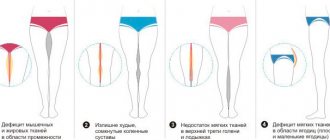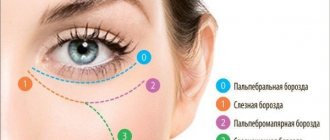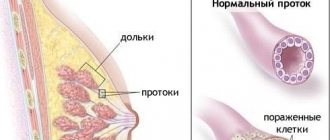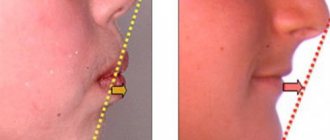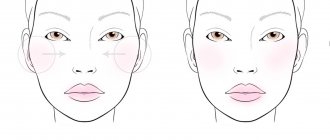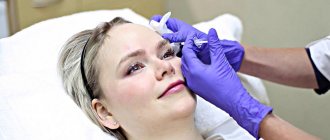Correction of a gummy smile with Botox in Moscow at Diamed
Most of our patients, before visiting cosmetology, mistakenly believed that the only way to get rid of their “horse smile” was surgery. Fortunately, there are less traumatic methods, one of which is Botox injections. They relax muscles by blocking nerve impulses. On average, a patient requires 2-3 units. 2 weeks after the injection you will forget about your gummy smile!
Sometimes a gummy smile is aggravated by a thin lip, in which case your esthetician will advise adding a little volume for medical purposes only.
Pathogenesis
The mechanism of defect formation is associated with the level of development of imbalances. A disorder may occur during the formation of the nasomaxillary complex, a genetically determined process that also depends on other factors: nutrition, pathology of the ENT organs, etc. Often, mouth breathing, which develops due to polyps, nasal injuries, and other reasons, forms the adenoid type of face. Due to the predominance of the vertical type of bone growth over the horizontal one, the face becomes elongated, the lower third increases, and the gingival zone is visualized in excess during a smile.
In the absence of skeletal abnormalities (improper growth and position of the jaws), a gingival smile is caused by excessive protrusion of the upper front teeth during eruption. The teeth “pull” the gingival tissue and underlying bone along with them due to hypertrophy, hyperplasia of cells, and their production of intercellular substance. With hyperplastic processes, the gingival tissue increases in volume; with muscle hyperactivity, the facial muscles in excess move the lip upward when smiling.
How is a gummy smile corrected?
Before the procedure, your doctor will invite you for a free consultation and confirm that the procedure will help you improve your aesthetic appearance. If you have an anatomically short upper lip or small teeth, a cosmetologist will not be able to correct your situation. But these are quite rare reasons.
Once confirmed, your esthetician will discuss with you a customized gummy smile correction plan tailored to the size and location of the levator labii muscles.
The procedure is painless, discomfort is minimal and lasts a very short period. But if you are afraid of injections, the doctor will offer you an anesthetic cream.
Injections are given directly into the muscles that produce a gummy smile. They are located on both sides of the nose. Within 3-4 days you will observe a transformation, the upper lip will seem to increase in height, covering your gums. You will see the absolute result 15 days after correction.
Orthodontic correction of high smile and dental problems
It is worth noting that a gummy smile in itself is not a pathology, it does not in any way affect the health of the teeth, and does not have a negative impact on the process of chewing and digestion.
But many owners of this feature, most of them women, want to get rid of it, make their face more harmonious, because with such visualization it is sometimes visible, for example, that the teeth are dentures, the color of the gums has changed to bluish, yellowish or purple, the gums are affected by periodontal disease. In this case, we are talking about smile aesthetics, which can be achieved by several types of correction.
If a gummy type of smile is the result of improper formation of the dentition, deformation of not only the teeth, but also the bone tissue of the jaws, the help of an orthodontist is required.
This method may include several types of orthodontic correction, depending on the type and degree of pathology, the age of the patient, and the presence of other pathological conditions.
Most often, orthodontic correction consists of straightening the teeth through long-term wearing of braces.
In most cases, this correction method is used in combination with others - for example, surgical or cosmetic.
Gum smile is easy to diagnose. The dentist is able to detect the deficiency already during the initial visit. If you look at the teeth in a gummy smile, you can immediately see the problem. Sometimes the upper teeth protrude forward. This leads to the fact that the lips cannot close completely when at rest.
In addition to visual defects, a patient with a gummy smile may have additional symptoms:
- Increased gum bleeding and systematic inflammation. They occur with soft tissue hyperplasia and excessive gum growth.
- Hyperfunction of facial muscles. There is increased tension in certain areas of the face and lips.
- Volumetric lower face. Occurs due to the growth of the upper jaw.
- Changing the direction of the upper incisors. They may move towards the mouth or tongue.
For diagnosis, a visual inspection is performed. To clarify the diagnosis, photographs and casts, as well as modeling, may be required.
What to do after correction of a gummy smile
After the procedure, you should follow a few simple recommendations:
- try not to smile for two days
- You should avoid facial massage for at least a month
- for 2 days, do not lift anything heavy, do not tilt your head down for a long time, avoid physical exertion
- During the week, avoid direct sunlight, do not visit the bathhouse or sauna.
On average, the effect after correction of a gummy smile lasts 4-6 months. Afterwards, the procedure should be repeated to maintain the aesthetic condition. If you don't continue to correct, nothing will happen! Your upper lip will just return to its previous state. You can resume injections at any time. Or don’t stop them, because they are absolutely harmless to the body.
Causes
From an anatomical and physiological point of view, the nature of a smile is determined by the contraction of the muscles of the middle and lower thirds of the face, during which the teeth and gums are exposed. That is, the attractiveness of a smile depends on the relationship of three elements: gums, teeth, lips. Violation of the correct proportions that form a gingival smile occurs for a number of reasons and their combinations:
- Features of soft tissues. The vertical size of the upper lip may be reduced compared to the average size, or its base may be attached too high. This contributes to excessive exposure of gum tissue when smiling. This effect is also observed with normal facial and dentofacial parameters, when hyperactive facial muscles excessively shift the lip upward.
- Dento-alveolar extrusion. This is the “lengthening” of the front teeth of the upper jaw due to excessive eruption. In this situation, the gum tissue moves down along with the underlying bone. Due to the low position of the upper front teeth, the gums become too visible with a wide smile.
- Dental anomalies. Excessive vertical growth of the upper jaw, caused by genetic and environmental factors, can lead to excessive exposure of the gums covering the anterior alveolar process. The cause of a gummy smile can also be anterior maxillary rotation, a disturbed relationship between the upper and lower incisors.
- "Excess" gum. Caused by hyperplasia (pathological increase in volume) of the gum, a delay in its natural migration towards the apex (apex of the tooth root) or low clinical crowns of the front teeth. Gum tissue covers a significant part of the tooth crown and becomes noticeable when you smile.
In the vast majority of cases, high gums when smiling are the result of individual developmental characteristics of the maxillofacial region of a person, which are formed in utero.
- Abnormal growth of the maxillofacial apparatus in infancy and childhood under the influence of various negative factors.
- Formation of malocclusion in a child.
- Irregular growth of teeth, their severe curvature and protrusion.
- Very short and thin upper lip.
- Shortening of the upper frenulum that was not corrected in time.
- Disproportionately small incisors on the upper jaw.
- Greater mobility of the upper lip.
- Spastic conditions in this area.
The gingivectomy method is indicated for conditions where there is too much gum above the upper teeth. As a result, it covers a very large part of the teeth, as if hanging over them, which forms a visual gummy smile.
Types of osteomucogingival surgeries in dentistry
It must be borne in mind that the results of this method are irreversible, so surgical correction is prescribed in the most extreme cases with the above-described features, and this happens infrequently.
In case of hypermobility of the upper lip, excessive facial expressions of the patient, when they cause the visualization of the gums when smiling and talking, there is an excellent method for correcting the condition - Botox injections, which relax the active muscles of this area and help reduce their mobility.
Treatment is achieved by administering bolutoxin type A (Botox and Dysport, popular drugs in cosmetology).
We suggest you read After Yesterday how to remove bad breath from alcohol
A gummy smile can be avoided by working on more than just your teeth. If the problem is a short upper lip, and the deficiency is not too pronounced, you can get by with minimally invasive procedures in the chair of a completely different doctor. Such methods began to be practiced relatively recently, but they are quickly gaining popularity in this area.
We are talking about introducing special substances into the upper lip that increase its volume. In this case, it will look plumper and will partially hide the gums when smiling, compensating for the deficiency. It is important not to overdo it, otherwise your face will look unnatural.
If you experience a gummy smile, Botox correction may also help. The fact is that an upper lip that is too mobile can rise too much. Therefore, injections of a special toxin are practiced that paralyzes the muscles in the mouth area. This allows you to reduce mobility and eliminate the defect.
The advantage of these methods is their relatively low cost, painlessness and simplicity. There is no need for a long healing period. Unfortunately, the effect is also short-lived - the procedure will have to be repeated every few months. Botox can even have an undesirable effect in the form of facial asymmetry.
When a person has “a lot” of gum that opens above the upper teeth when smiling, then part of the gum above the teeth can be surgically removed. This is the most difficult correction method. Yes, the method is very effective! But the method is irreversible. Using surgery, you can achieve very good aesthetic results. The complexity of the method lies in the fact that there are surgical risks, i.e.
healing of the gums and the formation of a new gum contour may not proceed as planned by the surgeon. Cutting off the gums above the teeth always leads to a visual lengthening of the teeth themselves. Those. The gums are shortened and the teeth are lengthened due to the exposure of areas of the teeth that were under the gum. In some cases, this is corrected by aesthetic restorations on the teeth (veneers, restoration made from filling material).
But in some cases, the visual lengthening of teeth after cutting off the gums itself leads to an aesthetic disaster! In order not to make a mistake, it is necessary to make the decision to trim the gums in order to correct a gummy smile not with one dental surgeon, but together with a surgeon and an aesthetic dentist.
Orthopedic dentist S.V. Zukor. Dial-Dent specialist in correcting gummy smiles using dental methods.
Why does the defect occur?
Who has this feature? Some attribute this facial feature to signs of Jewishness. In fact, there are many factors that can affect the appearance of your smile:
- jaw structure;
- malocclusion;
- problems with the location of individual teeth;
- hyperactivity of the upper lip;
- improper functioning of the orbicularis oris muscles;
- reduced crown sizes;
- proliferation of soft tissues, called hyperplasia in dentistry;
- special location of the bridle;
- small size of the lips themselves;
- high position of the upper jaw.
The majority of them are congenital anomalies or acquired in childhood. Therefore, it is possible to detect a gummy smile in a child and correct the defect in time so that it does not cause inconvenience or psychological discomfort when communicating with people. But sometimes there are cases when such a problem appears in an adult. For example, as a result of unsuccessful plastic or cosmetic interventions, injury, etc.
The majority of them are congenital anomalies or acquired in childhood. Therefore, it is possible to detect a gummy smile in a child and correct the defect in time so that it does not cause inconvenience or psychological discomfort when communicating with people. But sometimes there are cases when such a problem appears in an adult. For example, as a result of unsuccessful plastic or cosmetic interventions, injury, etc.
Cost of smile correction
The cost of correction depends on how the correction is performed. The cost is variable and depends on the region of residence of the patient. In the periphery, such a service is cheaper, but practice shows that more professional and experienced specialists can be found in Moscow, the region and St. Petersburg.
- Orthodontic treatment costs 30 thousand rubles or more. Depends on the material from which the correction systems are made and its service life.
- Surgical intervention costs at least 50–70 thousand rubles. The more experienced the specialist, the more expensive his work.
- Cosmetic correction is the most budget-friendly of all options. Injections cost 10–20 thousand rubles.
Symptoms and diagnosis
A gummy smile can be diagnosed by asking the patient to smile widely. When analyzing the problem in order to correctly select the method of its correction, the dentist can simultaneously identify various pathological conditions and processes (for example, bite pathology) that took part in the formation of the anomaly. The main diagnostic methods include:
- Questioning, external examination. Smile parameters are sequentially assessed. The psychological state of the patient is determined, great importance is given to his own opinion regarding the excessive visibility of the gums: whether he considers the problem an aesthetic defect, whether he wants to correct it.
- Taking photographs. They take photographs of the face from the front and in profile, with and without a smile. In certain cases, the dentition is photographed using a special intraoral mirror. A photographic protocol is drawn up for subsequent assessment of treatment results, sometimes for the purpose of preparing a presentation for the patient.
- Taking impressions. An impression is an accurate negative impression of the dentition and oral mucosa, usually obtained using alginate or silicone masses. Necessary for casting plaster models and their calculations, planning orthodontic treatment. Impressions are also taken before orthognathic operations.
- X-ray studies. Before orthodontic and surgical treatment, orthopantomography, computed tomography, and teleradiography are performed. Based on the resulting images, the condition of the teeth and bone tissue, sinuses is assessed, and the temporomandibular joints are examined. Calculations of various angles and linear dimensions are carried out.

